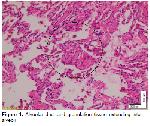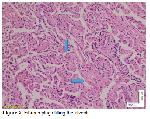Viral pneumonia findings may develop in the course of COVID-19 disease
19. Radiological changes are expected to peak approximately ten days after symptoms and then regress
20-22. In some cases, however, ground-glass opacities gradually transform into multifocal consolidation with septal thickening from the onset of symptoms
23-25. This case indicates progression to organizing pneumonia, a typical response to lung injury
18. However, the SOP pattern has been reported mainly as a late-phase complication
8. In our study, all patients were diagnosed in the post-COVID-19 period, consistent with the literature.
Baha and Yildirim. 26 have found the mean age at OP diagnosis was 57.0+/-12.6, and the male gender was predominant. The most common symptoms were cough (71.4%), dyspnea (66.1%), and fatigue (64.3%), and dyspnea has been reported to last from 10 days to 2 years. In another study 27, the mean age at presentation was 60.46±13.57, and fatigue, cough, fever, and dyspnea were the most common symptoms. In the present study, most of the patients were in the 20-29 and 40-49 age groups, and the mean age was 38 (±13.8). These results were consistent with the age range reported by Fang et al. 28 in a study investigating COVID-19 patients with secondary OP. Our study also showed that OP was more common in males, the most common symptoms were fatigue, shortness of breath, and other symptoms included high fever and cough.
Some of the most common causes of secondary OP are medications, infections, rheumatological diseases, and malignancies. In a study, the most common causes of SOP were rheumatological diseases and malignancies 26. In another study 29, the most common cause of SOP was infection. In this study, SOP developed after the COVID-19 infection in all patients.
Many studies have unexplained the relationship between smoking and OP 26,27,29. Lazor et al. 30 have found that 71% of OP patients were non-smokers, and most of them were female. Only one male patient who had a smoking history in our study is compatible with this outcome.
Similar to our study, in studies evaluating the laboratory parameters of organizing pneumonia patients, the presence of high CRP and ESR are noteworthy. However, the reasons for these higher values have not been clarified 31-33. CRP synthesis from hepatocytes during inflammation increases with the influence of cytokines such as interleukin 6 34. In the presence of OP, it has been shown that there is an increase in inflammatory cytokines 35. In addition, considering the role of acute inflammation in the etiology of SOP, increased acute phase reactants can be expected.
The most common radiological findings in patients with organizing pneumonia are consolidation and ground-glass opacities, with often bilateral-peripheral involvement. It has also been shown that the lower lung zones are more affected 36. Another study showed that middle zone involvement is prevalent 37. Our findings were consistent with the literature and showed that the predominant involvement of the lung's lower zone and the central location was detected, respectively.
Histopathological examination is the most valid method to diagnose organizing pneumonia 38. However, OP can be analyzed in appropriate clinical and radiographic findings 36. Cazzato et al. 39 have found that clinical and radiological findings usually support the diagnosis, but definitive confirmation requires histopathological examination in the diagnostic approach of patients with OP. In our study, the diagnosis was made by histopathological evaluation of all patients.
This is the first study to show the relationship between COVID-19 and SOP in a case series to the best of our knowledge. However, the study has some limitations. Our results need to be supported by well-designed, large-scale studies to determine the association between SOP and COVID-19 disease. In addition, the retrospective nature of the research and the relatively small sample size are among the limitations of the present study.
In conclusion, COVID-19 is a novel infection with severe medical conditions that have affected people worldwide for almost two years. Organizing pneumonia seen after COVID-19 pneumonia is one of the leading causes of lung injury manifested by different interstitial changes seen on CT scans. Despite few case reports to date, it has been suggested that OP is much more common in COVID-19 infection. In the light of all these findings, secondary OP, which represents an immunological process, should be considered among patients with COVID-19 pneumonia and should be evaluated to detect lung damage in the early period, especially in the case of persistent or recurrent respiratory symptoms and ongoing lung infiltrate. This study will increase clinicians' awareness of OP in the post-COVID period, resulting in reduced need for invasive mechanical ventilators and unnecessary antibiotic use and improved overall survival by enabling early diagnosis and treatment of the disease.
Source of funding: None.
Conflicts of interest: The authors have no conflicts of interest to declare






